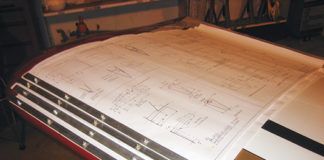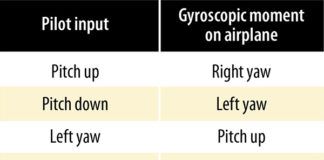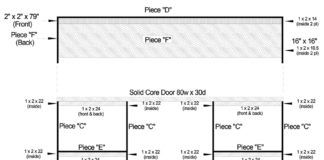Imagine being able to take off in your ultralight sailplane, using no more than 50 cents’ worth of energy to reach 2000 feet, then shutting off the lightweight motor, and soaring on the lightest thermals for the rest of the day. Envision having a lightweight aircraft that could be transported in a van or atop a compact car, and whose small, light components could be assembled and disassembled single-handedly. These are a few of the benefits of ultralight, electrified motorgliders, a type of airplane I see growing in number and prominence in the energy-hungry future.
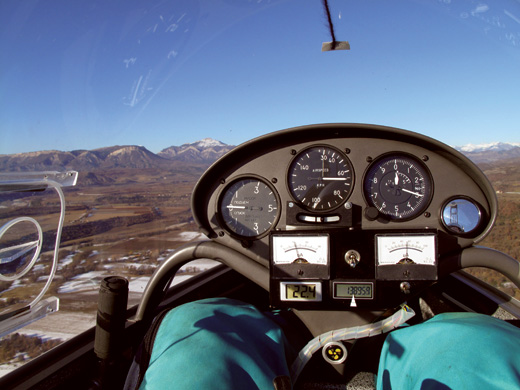
A lovely view from the Alatus cockpit. Note the electric gauges for the motor (power mast showing in the mirror) and the Russian variometer.
Numerous domestic and foreign designs suiting a wide range of flying styles are currently available, enough to require two articles to cover the field. Almost all are smaller than a standard-class sailplane with its 15-meter (49.2-foot) wingspan. Some are lighter than their prospective pilots, and some offer kit-build options that lower the initial cost of ownership. Electrical power adds to the positive experience.
Three approaches to placing the motors are evident in today’s designs, and the small size and high torque of many of these miniature power sources may lead to even more approaches.
Most common in the self-launching and sustainer motor field, the retractable arm and motor allow streamlining of the fuselage to its original clean lines, but introduce complications in the matter of extending the motor and nudging the prop into line to allow retraction of the power package. This can be a struggle in the cramped confines of a typical sailplane’s necked-down silhouette aft of the pilot. A disadvantage is that the extended boom adds drag when it is least desirable, sometimes dropping the glide ratio as much as extending spoilers would.
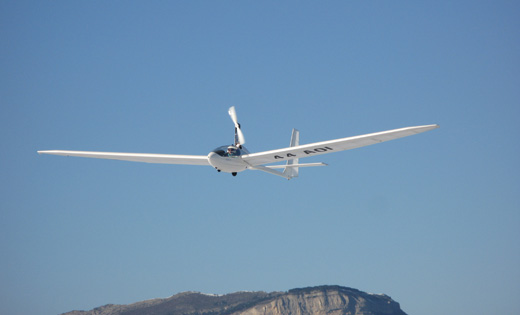
Michel Serane guides the Alatus-ME on its 1 hour, 7 minute flight.
Some motorgliders forgo the struggle with a fuselage design that has a pod-and-boom configuration that allows a fixed motor behind the pilot with a large enough space for batteries, motor controller and wiring. Being able to simply push the ON button and run the throttle forward permits easy “saves” when necessary. Space limited by boom placement at the top or bottom of the pod constrains propeller size, though.
Propellers can be mounted on the trailing edge of the wings, giving two small motors the potential to launch or sustain an airplane. Greg Cole of Windward Performance, LLC tried this approach a few years ago on a SparrowHawk, and it did fly. But he was unhappy with the performance and reliability of the foreign-made model aircraft motors.
A recent development from Slovenia, the Front Electric Sustainer (FES), was first tried on a 15- to 17-meter glass sailplane, the LAK 17. For large craft, the 15 kW (20.1 horsepower) motor can provide a modest rate of climb when activated, and has even been used following an auto tow launch. For smaller sailplanes such as the Silent 2, a 20 kW (26.8 hp) unit can provide self-launching and a healthy rate of climb.
Regardless of configuration or structure weight for the airplane alone, Randall Fishman of ElectraFlyer warns that battery weights are still significant enough to plop the otherwise svelte ultralight into a welterweight category that might require a pilot’s license, medical certificate and other trappings of officialdom. European definitions of “ultralight” do not coincide in many instances with American definitions, our continental cousins often having greater latitude in weight, speed and range over our Part 103-compliant machines.
One aspect of this is whether batteries’ weak power-to-weight ratio compared to gasoline should be taken into consideration. A gallon of gasoline can produce the equivalent of 33.7 kilowatt hours of energy. Fishman estimates it would take 600 pounds of batteries to produce an equivalent energy. The 27.5-pound battery pack on the lightest of our sample provides 1200 watt hours, or 1.2 kWh.
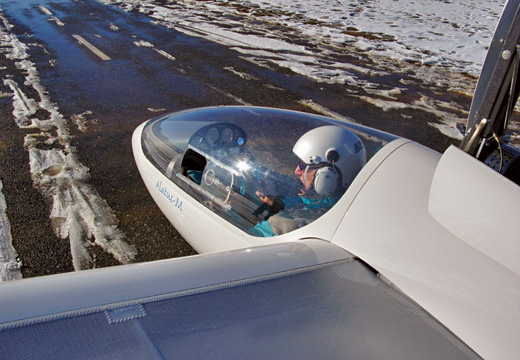
The Alatus-M. Hang-glider technology with ripstop covering on the wings, motor at the base of the mast, and belt drive to the propeller.
Alatus-M
Electravia, following the successful testing of a Lynch motor and 47- kilogram (103.4-pound) battery pack on its Souricette ultralight, installed the motor on an Alatus AL-12 motorglider in 2009. The superior aerodynamics of the motorglider (a reported 27:1 lift-to-drag ratio) allowed over an hour’s flight on a battery pack less than half the weight of that on the ultralight.
Electravia has also flown a trike on this power system. The Souricette, though it uses the same motor as the Alatus, is a far “draggier,” heavier machine and requires a battery pack double the size of that in the Alatus for less duration. The Alatus managed 1 hour, 7 minutes on its 20-kilogram (44-pound) battery, the Souricette 48 minutes on its larger pack. Alatus test pilot Michel Serane managed to gain 2100 meters (6890 feet) during the flight, with probably few thermals because of the wintry temperatures.
The Alatus uses aluminum tubes and ripstop fabric, a la hang-glider technology. It meets FAR 103 rules and the criteria of the German LTF-UL and DULSV LFG.
With an empty weight of 125 kilograms (275 pounds) and maximum weight with pilot of 235 kilograms (517 pounds), the Alatus-ME is very light for a 13-meter-span sailplane, especially one with motor, controller and batteries.
The penalty for electric power in this case is minimal, adding only 18 kilograms (39.6 pounds) to that of an Alatus with a small two-stroke engine and fuel.
With a wing loading of only 17.3 kilograms per square meter (3.54 pounds per square foot), the Alatus floats neatly into U.S. ultralight territory, with a best lift-to-drag ratio of 27:1 at 60 kilometers per hour (37.2 mph), minimum sink rate of 0.65 meters per second (2.13 feet per second) and a stall speed of 41 to 45 kilometers per hour (25.4 to 27.9 mph). A Vne of 140 kilometers per hour (86.8 mph) allows a safe maneuvering limit for thermalling.
Anne Lavrand, head of Electravia, quotes 36 Euros for a full recharge, meaning an hour’s powered-on time would cost about 50 cents.
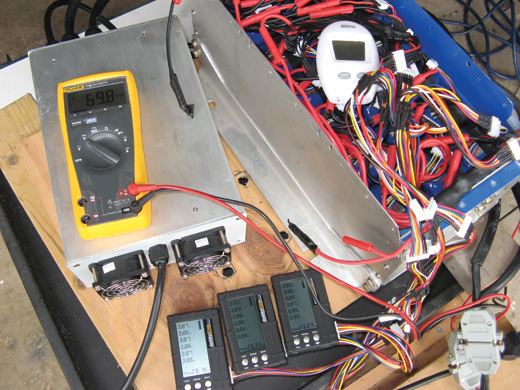
A battery charging test runs on the Red Tail Hawk.
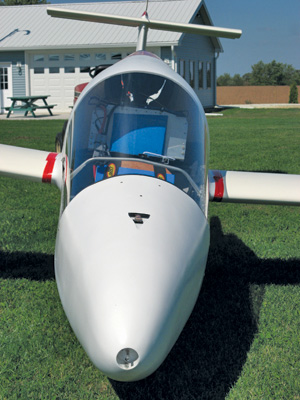
The RTH shows off its high-aspect-ratio wings and a flat-wrap canopy.
Red Tail Hawk (RTH)
Jerry Booker, a retired engineer in central rural Illinois, designed a pod-and-boom powered sailplane based largely on the writings of Dr. Alex Strojnik, a physicist at the University of Arizona whose hobby was laminar flow on small aircraft.
A self-effacing type, Booker explains, “In addition to Alex Strojnik, I got a lot from the late Stan Hall’s writings, and from the late Bob ‘Veedubber’ Hoover (who wrote extensively and knowledgeably about Volkswagen engines), whose writings inspired me to write about my projects to try to pass on some knowledge and experience.”
He does not seek publicity for himself or his work. “As there is no intention of my efforts leading to a business endeavor on my part,” Booker said, “I just want to show there is a way that a homebuilder can put together a Part 103-compliant, electric-powered, self-launching sailplane, and then maybe somehow help others who have a serious intent in doing something similar.”
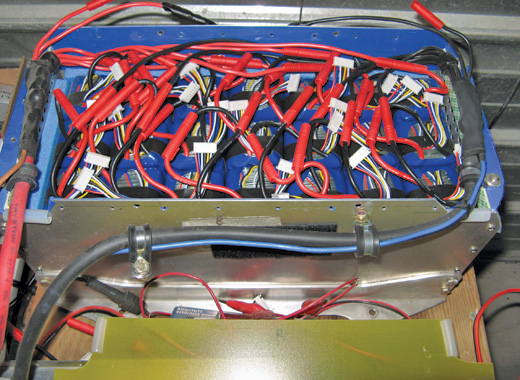
The Hawk’s battery assembly fits neatly right behind the pilot.
Booker’s Red Tail Hawk has wings based on Monnett Moni spars and a planform with a long, rectangular center section and tapered outer panels. Flaps and ailerons provide lateral control and a selected glideslope. The landing gear and flat-wrapped canopy tend to follow Strojnik’s rules, explicated in three volumes on design, structure and technology.
Motor selection was influenced by Fishman, from whom Booker purchased his motor and controller, a package tested on Fishman’s ElectraFlyer-C, which won the Lindbergh Award a few years ago. Batteries were chosen after talks with Mark Beierle of Earthstar Aircraft, according to Booker, and he ended up with a set of radio-control packs used in large model airplanes. They fit neatly into a battery box located just behind the pilot’s shoulders.
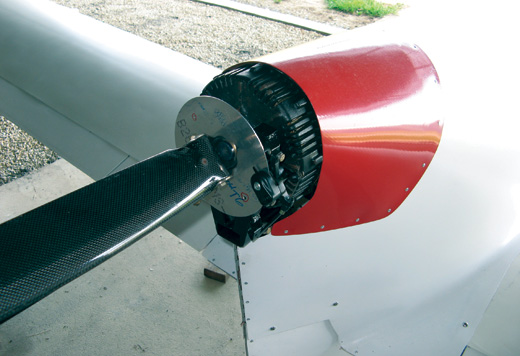
The motor, motor fairing and folding propeller on the RTH. Note the brake to keep the prop from windmilling and prevent folding.
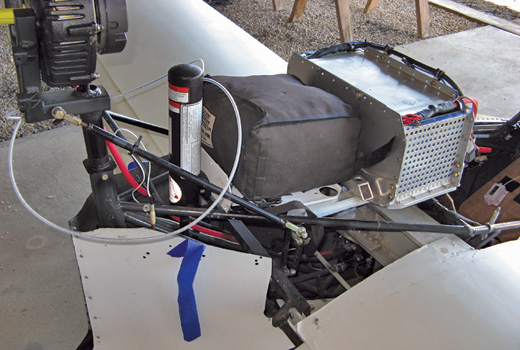
RTH under the turtledeck. Its compact systems (from left) include motor, ballistic parachute and vented battery box, all in the limited space behind the pilot’s seat.
When asked on the CAFE Foundation blog about how he selected his power system and how that’s worked out, he replied: “The biggest issue in buying a proven, complete power package is that it saved me probably a couple of years of trial and error trying to come up with my own combination that worked and was reliable. Probably saved me money, too, because the error part of the trial-and-error method can get very expensive when dealing with this kind of stuff.
“Operating the electric power system is a dream, compared to trying to fly the RTH with a small single-cylinder, two-stroke engine, which tried to shake the poor thing to pieces. Now I just get in; all is quiet as I go through my checklist. When ready, I open the ‘throttle,’ which starts the motor spinning, the propeller unfolds, and away I go.
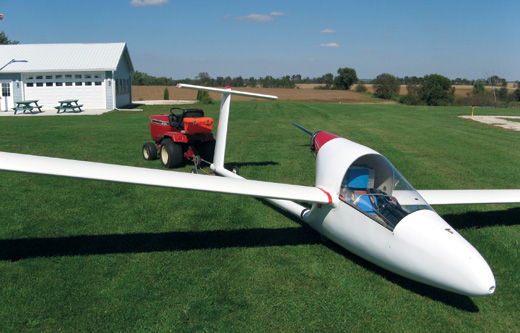
Red Tail Hawk has slender lines, a high-mounted electric motor and a folding prop.
“Charging the battery pack is still a big issue, though. I still need to monitor it closely, but I’m quite sure that will improve shortly as new chargers and balancers for these big RC-based battery packs come along. Several are being developed by some folks on the Endless-Sphere E-bike forum.”
Booker’s ongoing flight tests and continuing upgrades to RTH are well documented in his Yahoo Group’s forum. He prefers correspondence through that means to allow all interested parties to benefit from the forum’s give and take. He has posted several videos of his flights and is quick to respond to constructive suggestions.
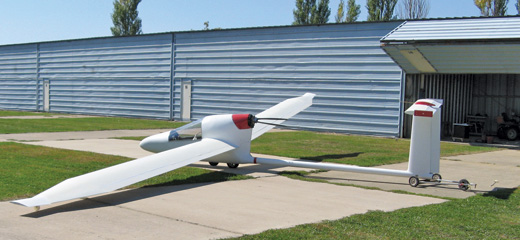
That eponymous red tail and the motor fairing on the RTH.
Silent 2
Alisport’s Silent motorglider was the first to employ a mast-mounted, retractable electric motor, and variants have flown in many European countries with at least two types of motors. It has since become the recipient of the FES, developed by Slovenian father-and-son team Matija and Luka Znidarsic. The FES comprises a nose-mounted outrunner-type electric motor, controller and battery packs placed behind the pilot. The original retractable motor version of the Silent is no longer produced by Alisport.
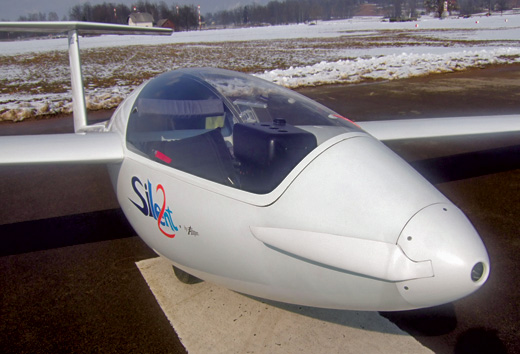
The Silent’s nose prop folded. The blades follow the nose contours, resulting in minimal drag when the prop is folded.
Speaking with Leo Benetti-Longhini, the American distributor for the Silent 2, was instructive. He noted the difference between European and American standards for ultralights. European ULM standards place the motorglider solidly in the ultralight machine category, but it would not meet American performance or weight requirements. In Italy, it meets VDS (Light Sport Aircraft) standards, not of the Italian CAA, which does not regulate this sub-category of aircraft, but of the AeCI, the Aero Club Italia.
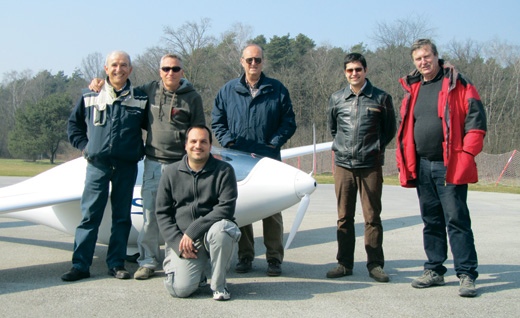
The Silent group: Luka Znidarsic (kneeling) and Matija Znidarsic (right) with the Silent 2 flight-test staff.
Benetti-Longhini also distinguishes between a “touring” motorglider, similar to the Fournier RF-series, and a self-launcher. Most self-launching sailplanes have a noisy engine mounted on a mast that puts the spinning propeller just inches from the pilot’s head. He tends to dissuade potential clients from going this route and is quite happy with the new approach.
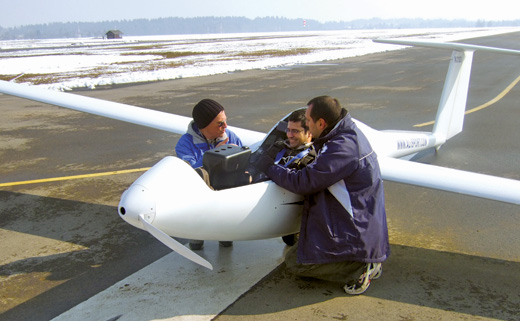
Silent’s test pilot Luka Znidarsic (right) briefs the current pilot.
The Silent 2 Electro with FES has a brushless, outrunner-type motor with an electronic speed controller. According to FES, The 20 kW (continuous power) unit with two battery packs of 14 43-amp-hour lithium polymer cells in series enables the 290-kilogram (638-pound) sailplane to take off on its own and cruise for 130 kilometers (80 miles) or climb 1800 meters (5700 feet) at 3 meters per second (576 feet per minute), all at once or in stages. A pilot can make a very high launch or save up for areas of no lift (which do happen). The cells are monitored and supervised by a battery management system, which allows even and full charging of each cell, giving the greatest endurance possible.
The motor, only 120mm long and 180mm in diameter, weighs a mere 9.5 kilograms (20.9 pounds) and fits neatly in the nose of the motorglider just ahead of the pilot’s feet and rudder pedals.
The position of the folding propeller requires no trim change on actuation or shutdown, easing the pilot workload considerably when compared to a retractable motor type. It also creates little additional drag, making for a lower power requirement for cruise.
Summing Up
These three designs represent configurations most common to the current motorglider environment. There are myriad other possibilities, and electric power will allow previously undreamed of combinations for future fliers. We’ll look at more such examples next month, with the expectation that even more creative and surprising innovations are headed our way.

![]()
Dean Sigler has been a technical writer for 30 years, with a liberal arts background and a Master’s degree in education. He writes the CAFE Foundation blog and has spoken at the last two Electric Aircraft Symposia and at two Experimental Soaring Association workshops. Part of the Perlan Project, he is a private pilot, and hopes to get a sailplane rating soon.

